Beulah Morris Rhoads (1829-1923)
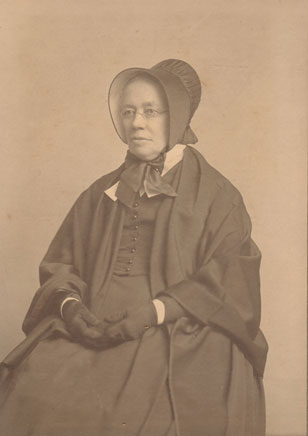
Beulah Morris Rhoads
Photo courtesy of the Historical Society of Haddonfield
Beulah Morris Rhoads is one of only a few women among the major donors to the ornithology collection. The portrait that emerges of her from her letters and diaries is of an independent spirit, a devout Quaker intensely interested in her family and its history, beloved by her stepchildren and nieces. Although we only have fleeting glimpses of her relationship with the Academy, her contributions helped fund the acquisition of nearly 1,000 birds from Central America and the Galapagos.
The Morrises were prominent Philadelphia Quakers, brewers, patriots, and merchants who traced their ancestry to the century before the Revolutionary war. Beulah Morris Rhodes’ father, Samuel Buckley Morris, followed the family line as a successful merchant, until the sudden death of his wife, Hannah Perot Morris, in 1831. Grieving, Morris left the business world behind and devoted himself to raising his three young children. He moved his family to his father-in-law’s summer home in the then bucolic Germantown. Now a National Park Service site known as the Germantown White House, President George Washington had occupied the residence in 1793 and 1794 during the yellow fever epidemic.
The house remained Beulah Morris’ home until her 1870 marriage to Charles Rhoads, a real estate lawyer and fellow Quaker. They were both 42 years old; he was a widower with four children. Together, they had one child, Mary, who died in 1872, just before her first birthday. From her letters, diaries, and carefully preserved recipes, now in the archives of the National Park Service, it is clear that Beulah M. Rhoads enjoyed a particularly warm relationship with her stepchildren as well as with the children of her two brothers. Her charmingly illustrated letters and postcards from an 1882 vacation in Bar Harbor, Maine also reveal substantial artistic skill.
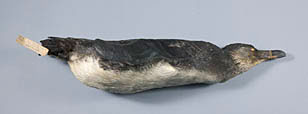
Galapagos Penguin
(Spheniscus mendiculus)
ANSP 39643
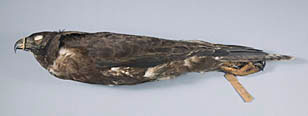
Galapagos Hawk
(Buteo galapagoensis)
ANSP 39607
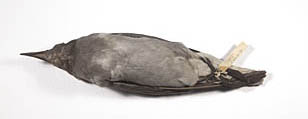
Lava Gull
(Larus fulginosus)
ANSP 39623
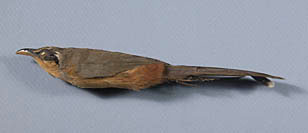
Lesser Ground Cuckoo
(Morrococcyx erythropygus macrourus)

Lesser Roadrunner
(Geococcyx velox pallidus)
ANSP 63745

Keel-billed Toucan
(Ramphastos sulfuratus brevicarinatus)
ANSP 63727, Paratype
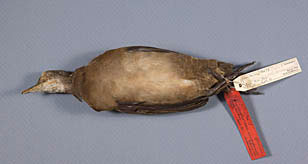
Little Tinamou
(Crypturellus soui meserythrus)
ANSP 63613
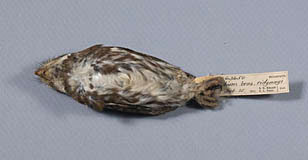
Ferruginous Pygmy Owl
(Glaucidium brasilianum ridgwayi)
ANSP 63650

Tourquoise-browed Motmot
(Eumomota superciliosa sylvestris)
ANSP 64723, Holotype
Mrs. Rhoads was devoted to studying and preserving her family’s history. She commissioned copies of fragile family documents, took measures to ensure the preservation of other heirlooms and researched her namesake, her great-aunt Beulah Sansom, a minister who had been a vocal advocate for abolition and African-American causes. This was a concern her husband seems to have shared. An 1876 Philadelphia Inquirer article mentions his speech at the annual meeting of the Friends’ Association for the Relief of Colored Freedmen. The organization provided support for schools and other necessities for African-Americans in the post-War South. At one point, it was led by Beulah Rhoads’ younger brother, Elliston Perot Morris.
Formal involvement with the Academy began in 1875 when Beulah M. Rhoads was elected a member. At a time when many women made donations under their husband’s names, she and Charles Rhoads are credited with separate gifts of $100 each, about $2,700 in today’s money, to the institution’s general fund in 1896 and 1900. In 1902, she is independently named as one of the seven donors who helped the Academy acquire a valuable series of birds collected by Rollo Beck in the Galapagos. She also purchased the Poyser collection of ferns for the Academy in 1914.
In the early part of 1901 (January and February), R. H. Beck collected birds on the Galapagos Islands that subsequently came to the Academy through the generosity of Academy benefactors. Beck was one of the greatest bird collectors of all times, with huge series of his specimens (most are seabirds or oceanic island specialists) now housed in all of the world’s great museums. His work in the Galapagos is particularly important, as the specimens are some of the few ever collected from the islands. Certainly none will ever be collected again from this vulnerable environment. At least 125 study skins, all endemic to the Galapagos Islands, make up this wonderful and unique collection. Perhaps the most widely known of the species Beck collected are the “Darwin’s” finches (genus Geospiza) but from a collection standpoint, the real jewels are specimens that now represent endangered species such as the Galapagos Penguin (Spheniscus mendiculus, ANSP 39643), Galapagos Hawk (Buteo galapagoensis, 39606-7), and the Galapagos Gull (Larus fuliginosus, 39622-3).
Beulah M. Rhoads’ final gift to the Academy underscores her commitment to her family. Her stepson, Samuel Nicholson Rhoads, also a major donor to the collection, traveled to Guatemala with Earl L. Poole in 1915 where they collected 700 bird specimens. She helped fund this expedition, as well as the purchase of more than 100 additional specimens from Panama. Her son-in-law, William T. Elkinton, the husband of her stepdaughter Eleanor, joined her in funding the expedition.
Samuel Nicholson Rhoads and Earl Lincoln Poole collected 810 study skins while working in Guatemala in early 1915. Most of the field work was conducted in central southern Guatemala, an area now almost completely devoid of the pristine environment they would have encountered, it now being planted with coffee and used as grazing land for cattle. The collection is composed of many of the common locally breeding birds along with several wintering birds that breed in North America. Rhoads and Poole discovered six new species on this trip; Berylline Hummingbird, Amazilia beryllina motaguae (ANSP 131661), Buff-breasted Flycatcher, Empidonax fulvifrons fusciceps (121441),Turquoise-browed Motmot, Eumomota superciliosa sylvestris (64723), Lesser Roadrunner, Geococcyx velox pallidus (63745), Keel-billed Toucan, Ramphastos sulfuratus brevicarinatus (63727), and Keel-billed Toucan, R. s. intermedius (63729). Collecting and preparing birds in the field is difficult business and there are certain species that can be particularly hard to collect, as they are visually quite cryptic, remain silent for long periods, or are in very low density. Examples of such taxa collected by Rhoads and Poole include; Little Tinamou, Crypturellus soui (63612-3), Ferruginous Pygmy Owl, Glaucidium brasilianum (63646-50), Roufous Mourner, Rhytipterna holerythra (64023), and Lesser Ground Cuckoo, Morococcyx erythropygus macrourus (63741-3).
An unusual woman, Beulah M. Rhoads both conformed to and departed from expectations for women of her era, religion, and social class. Her relationship with the Academy is only one chapter in her remarkable personal story.